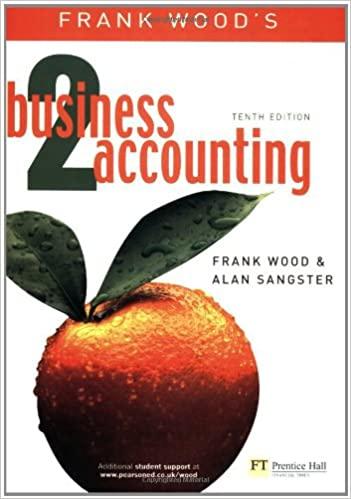Question
Consolidation subsequent to date of acquisitionEquity method with noncontrolling interest, AAP, and downstream intercompany inventory sale Assume, on January 1, 2016, a parent company acquired
Consolidation subsequent to date of acquisitionEquity method with noncontrolling interest,
AAP, and downstream intercompany inventory sale
Assume, on January 1, 2016, a parent company acquired a 70% interest in its subsidiary. The total fair
value of the controlling and noncontrolling interests was $160,000 over the book value of the subsidiarys
Stockholders Equity on the acquisition date. The parent assigned the excess to the following
[A] asset:
Asset Initial Fair Value Useful Life
Property, plant & equipment. . . . . . . . . . . . . . . . . . . . . . . . . . . . . $160,000 10 years
This acquisition resulted in no recognized goodwill. Assume the parent sells inventory to the subsidiary
(downstream) which includes that inventory in products that it ultimately sells to customers outside of
the controlled group. You have compiled the following data as of 2018 and 2019:
The inventory not remaining at the end of the year has been sold outside of the controlled group. The
parent uses the equity method of pre-consolidation investment bookkeeping. The parent and the subsid-
iary report the following pre-consolidation financial statements at December 31, 2019:

a. Disaggregate and document the activity for the 100% Acquisition Accounting Premium (AAP),
the controlling interest AAP and the noncontrolling interest AAP.
b. Calculate and organize the profits and losses on intercompany transactions and balances.
c. Compute the pre-consolidation Equity Investment account beginning and ending balances
starting with the stockholders equity of the subsidiary.
d. Reconstruct the activity in the parents pre-consolidation Equity Investment T-account for the
year of consolidation.
e. Independently compute the owners equity attributable to the noncontrolling interest beginning
and ending balances starting with the owners equity of the subsidiary.
f. Independently calculate consolidated net income, controlling interest net income and
noncontrolling interest net income.
g. Complete the consolidating entries according to the
C-E-A-D-I sequence and complete the
consolidation worksheet.
2018 2019 Transfer price for inventory sale. Cost of goods sold Gross profit... % Inventory remaining Gross profit deferred... EOY receivable/payable.. $210,000 (150,000) $ 60,000 40% $200,000 (170,000) $ 30,000 30% $ 24,000 $ 9,000 $ 30,000 $ 20,000 Parent Subsidiary Parent Subsidiary $1,500,000 (1,000,000) 500,000 Income statement: Sales. Cost of goods sold Gross profit. Income (loss) from subsidiary Operating expenses Net income.. Statement of retained earnings: Beginning retained earnings. Net income Dividends.. $ 80,000 210,000 340,000 Balance sheet: Cash... Accounts receivable Inventory.. Equity investment. Property, plant and equipment, net $6,400,000 (4,500,000) 1,900,000 143,800 (1,600,000) $ 443,800 $ 400,000 600,000 800,000 761,700 2,800,000 $5,361,700 (300,000) $ 200,000 800,000 $1,430,000 $1,237,900 443,800 (120,000) $1,561,700 $ 715,000 200,000 (50,000) $ 865,000 Current liabilities Long-term liabilities. Common stock ... Additional paid-in capital.. Retained earnings $ 500,000 2,000,000 400,000 900,000 1,561,700 $5,361,700 $ 125,000 300,000 60,000 80,000 865,000 Ending retained earnings $1,430,000 2018 2019 Transfer price for inventory sale. Cost of goods sold Gross profit... % Inventory remaining Gross profit deferred... EOY receivable/payable.. $210,000 (150,000) $ 60,000 40% $200,000 (170,000) $ 30,000 30% $ 24,000 $ 9,000 $ 30,000 $ 20,000 Parent Subsidiary Parent Subsidiary $1,500,000 (1,000,000) 500,000 Income statement: Sales. Cost of goods sold Gross profit. Income (loss) from subsidiary Operating expenses Net income.. Statement of retained earnings: Beginning retained earnings. Net income Dividends.. $ 80,000 210,000 340,000 Balance sheet: Cash... Accounts receivable Inventory.. Equity investment. Property, plant and equipment, net $6,400,000 (4,500,000) 1,900,000 143,800 (1,600,000) $ 443,800 $ 400,000 600,000 800,000 761,700 2,800,000 $5,361,700 (300,000) $ 200,000 800,000 $1,430,000 $1,237,900 443,800 (120,000) $1,561,700 $ 715,000 200,000 (50,000) $ 865,000 Current liabilities Long-term liabilities. Common stock ... Additional paid-in capital.. Retained earnings $ 500,000 2,000,000 400,000 900,000 1,561,700 $5,361,700 $ 125,000 300,000 60,000 80,000 865,000 Ending retained earnings $1,430,000Step by Step Solution
There are 3 Steps involved in it
Step: 1

Get Instant Access to Expert-Tailored Solutions
See step-by-step solutions with expert insights and AI powered tools for academic success
Step: 2

Step: 3

Ace Your Homework with AI
Get the answers you need in no time with our AI-driven, step-by-step assistance
Get Started


